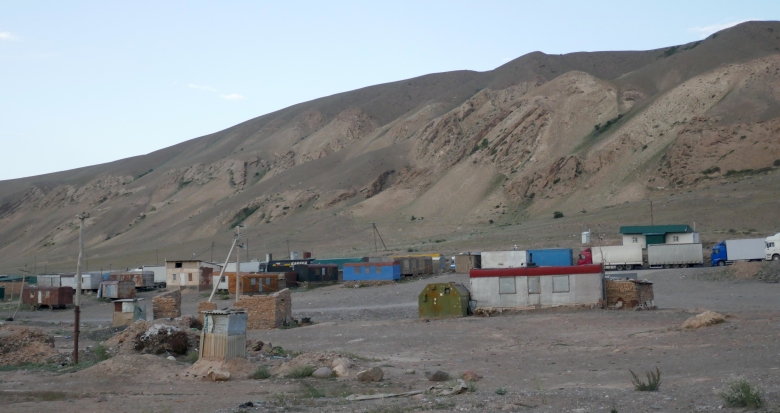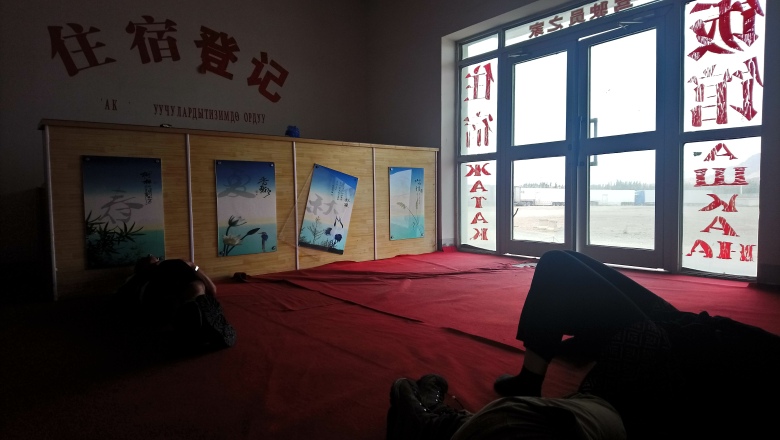For the statistics, practical information and the report on day 1, see part 1.
Day 2 (Monday)
According to Caravanistan.com, Irkeshtam is the easier of the two Kyrgyz border crossing into China, which does not mean that it is easy. So I was prepared that the crossing would take a while. I was not expecting that it would take that much time, though. But the Chinese side is perfect for a border tourist: There are lots of different checkpoints with different functions, and they always hold you up for a while, so that you can really indulge in the border atmosphere. Here’s a chronological report on all those stages.
7:00 am. Two Kyrgyz boys knock at the doors of the container. Kaisa from Finland, and me, who had slept in the same shabby box, wake up and wonder why the hell so early. The border does not open before 8 am, and there is hardly an entertainment block in between. But their knocking starts the passport party, which will turn out to be the best so far.
 Irkeshtam, the Kyrgyz border settlement where I had spent the night.
Irkeshtam, the Kyrgyz border settlement where I had spent the night.
8:00 am. The Kyrgyz border post opens and the Swiss cyclist immediately passes. Once more, the Kyrgyz check is friendly and a brief affair. No luggage check, no silly questions, just a stamp in the passport and a goodbye. Kaisa and me join the German adventurers, who offer us a lift to the actual border, 4 km away.
8:40 am. We reach the border between the former Soviet Union and the People’s Republic of China. A last Kyrgyz checkpoint, a last glance at my passport, a last conversation in Russian. Ahead lies China, and I speak no Chinese. We walk up the road, and after a road bend and a little creek we spot the first Chinese road sign. Some monuments and Chinese slogans follow. They look impressive in this barren mountain landscape, which appears profoundly un-Chinese. I resist taking pictures.

10:48 am (Beijing time, 2 hours ahead of Kyrgyzstan). Just 500 meters away from the border, we reach a small gate: The first Chinese checkpoint. An officer copies our first names and passport numbers into a big and important looking book. He flags down a Kyrgyz truck and makes us ride with him. After 4 km, we arrive at the first serious checkpoint.
11:05 am. The most feared part of this crossing is Simuhana checkpoint. Here, the Chinese check the luggage and go through all electronic devices – yes, also the browser history, at least according to some accounts. So plan ahead. What you do not get is the entry stamp – this is done at another checkpoint, 140 km down the road. So Simuhana is a really bad deal: A lot of control and no reward. Simuhana is an enormous building, but it is under reconstruction and there is no evident entrance. But we find a way in, and we find that we are not alone: Two Chinese, the Swiss cyclist and an Israeli tour guide are already waiting in a room, along with a pile of disassembled chairs and tables. Border guards come and go and take away all the furniture, but they ignore us. The whole terminal is almost empty, technically open (officially after 10 am Bejing time), but nothing goes on. There is no queue, no other travellers, but still we wait for an hour.
12:00 am. Our little group is finally checked. The most bizarre thing is that everybody has to stand on a conveyor belt, which slowly sends us through a body scanner. Besides that, the luggage check is rather superficial and friendly (which Chinese official generally are), and only one of us has to show the content of the mobile phone. After ten minutes of checking, we are sent to a new waiting room, and continue to wait.
1:00 pm. A taxi driver arrives and collects our passports from the border guards. The driver offers to drive us down to Uluqgat for 100 CNY (about 14 EUR) per Person. Uluqgat is the main immigration checkpoint. There is no other choice and the price seems to be quite OK, so we agree. We cover the 140 km in two hours, with just one brief stop for an intermediate checkpoint.
 Amazing landscape on the Chinese side of the border.
Amazing landscape on the Chinese side of the border.
3:08 pm. Ulugqat checkpoint, finally! So we think. But – surprise, surprise! – it turns out that the immigration officers are already in their lunch breaks. What the heck are they doing during the morning shift? After all, we were the first to leave Kyrgyzstan that morning, nobody could have been ahead of us! We are dumped at an empty, shabby trucker’s motel, and after half an hour, I am surrounded by snoring tourists, lying on the bare floor of the motel’s lobby.
 Lobby of a trucker motel in Ulugqat, where we waited for one and a half hours.
Lobby of a trucker motel in Ulugqat, where we waited for one and a half hours.
4:30 pm. The taxi driver wakes everybody up. It looks like the lunch break is over, and we will finally make it to the actual border control. Will we really get the stamps? I am cautiously optimistic. We get to the immigration building: Again, a huge terminal. And again, we find it empty. We sit down and wait. Nothing happens. After a while, a lady appears and measures our temperatures: Disease prevention. That is it for the moment.
5:30 pm. The immigration desk finally opens. Just as a reminder: We had left Kyrgyzstan right after the border had opened this morning. The immigration terminal is a huge hall, and our group of five feels a bit lost in front of the only open counter. The checks again take time, and my check in particular. Some detail of my passport has to be verified by an expert, who is based at the other end of the terminal, at the exit control. But everything is fine, and I finally get my entry stamp. Afterwards, there is a customs check, which surprisingly takes only one minute.
6:08 pm. We finally made it through. The friendly customs officer calls a taxi for Kaisa, the Israeli and me. Two minutes later, we are on our way to Kashgar.
Epilogue. After two more passport checks on the highway and two hours of drive, we finally get to the historic old town of Kashgar. The city looks like under siege – a lot of police, and few people on the street. Apparently, a big conference is going on, so the security is tight. We do not complain: Just after leaving the taxi, we stop for a Lamien (Chinese Ramen) snack. Noodles, chickpeas, a spicy sauce and coriander – it is my best meal since weeks! I feel very happy to be in China.
 Chinese Central Asia: The (reconstructed) old town of Kashgar.
Chinese Central Asia: The (reconstructed) old town of Kashgar.

Considering you are travelling in the region, may I ask: how did you apply for your Chinese visa? Did you apply at an embassy in your home country or while on the road?
LikeLike
I applied in my home country. And I did not mention that I would enter from Kyrgyzstan. First of all, I would have had to file in a ticket, which is impossible to organize in advance. Second, the Chinese embassy apparently tends to deny visa requests for Xinjiang.
LikeLike
Hello. Thank you for you blog. We are in Osh at the moment and we plan to cross the border this friday at Irkeshtan pass. We hitching from france and we would like to avoid to take the taxi for the no mans land area. Do you know if it is possible ? Maybe finding a lift in Kyrgys part ? Do you think it is possible ?
LikeLike
Hello Vincent. There is a daily bus from Osh up to the border settlement, Irkeshtam. It leaves Osh market around noon – ask around the day before. If you then spend the night in Irkeshtam, you have plenty of time to ask truck drivers for a lift. However I am not sure if the Chinese border guards would accept that. NB: The taxi I took was between the first and the second Chinese border post, so not in no man’s land. And it seems the Chinese demand all tourists to take these taxis, even the cyclists. They are rather strict on that. As for the area between the Kyrgyz and the first Chinese border post, it is very easy to just spontaneously flag down a truck.
LikeLike